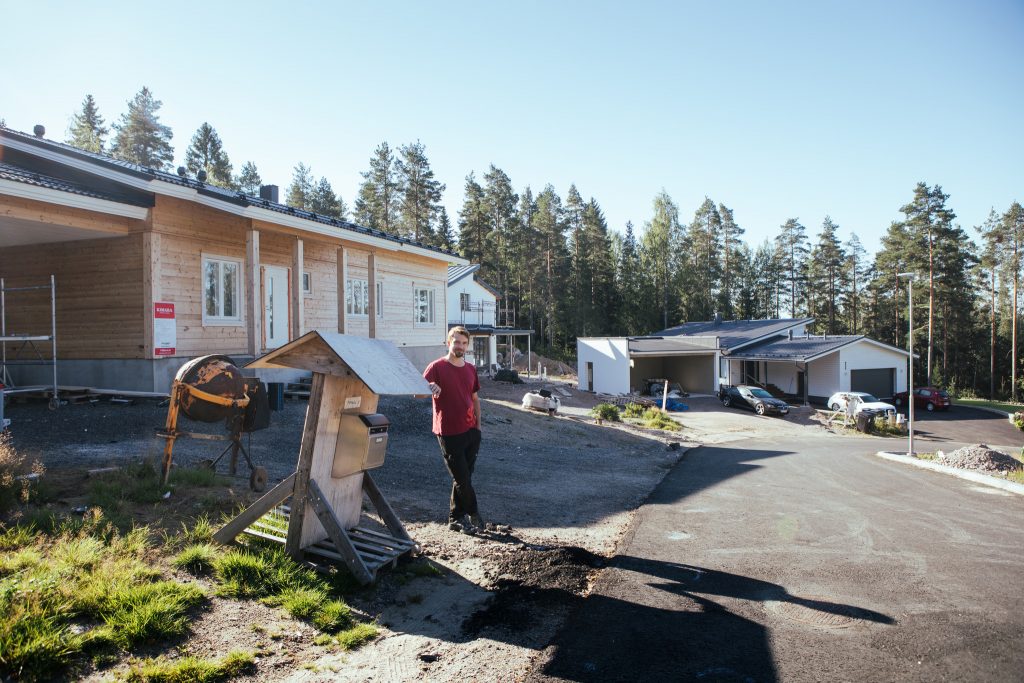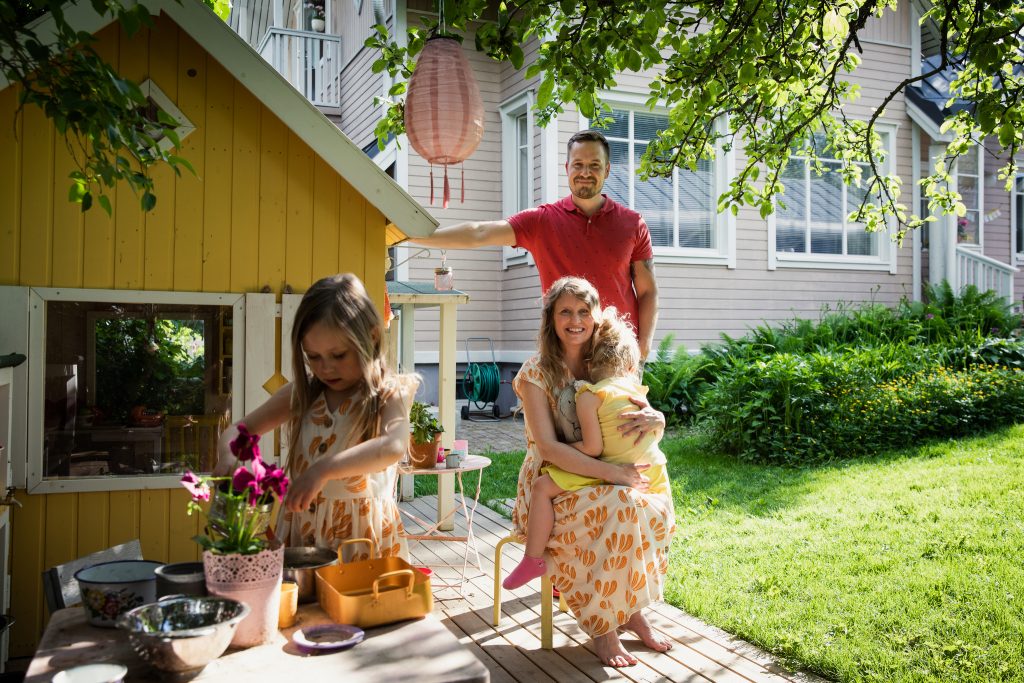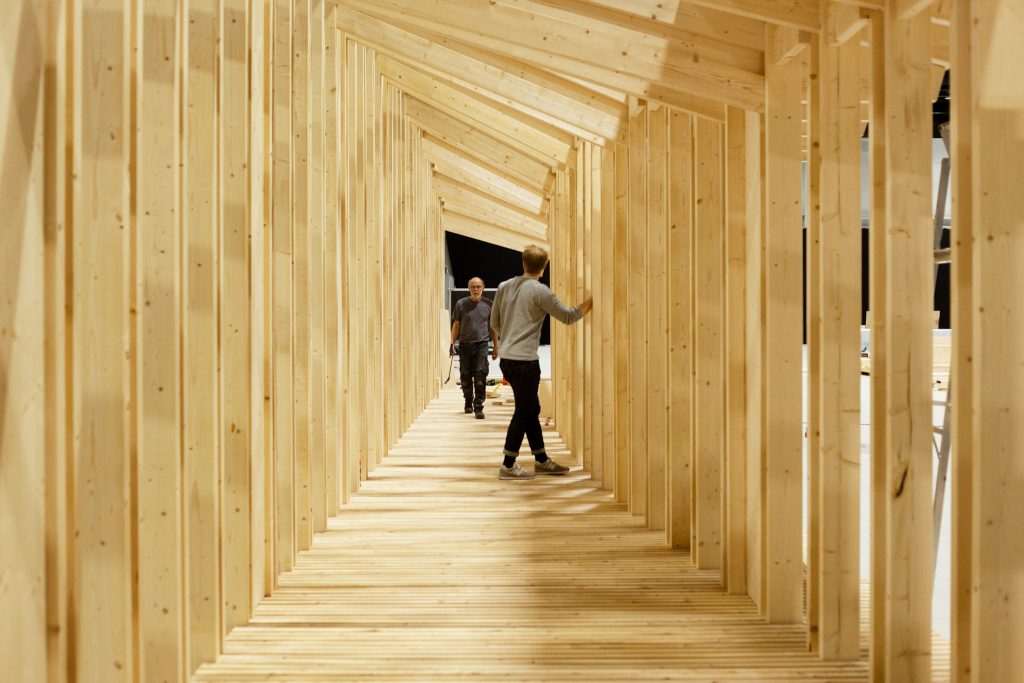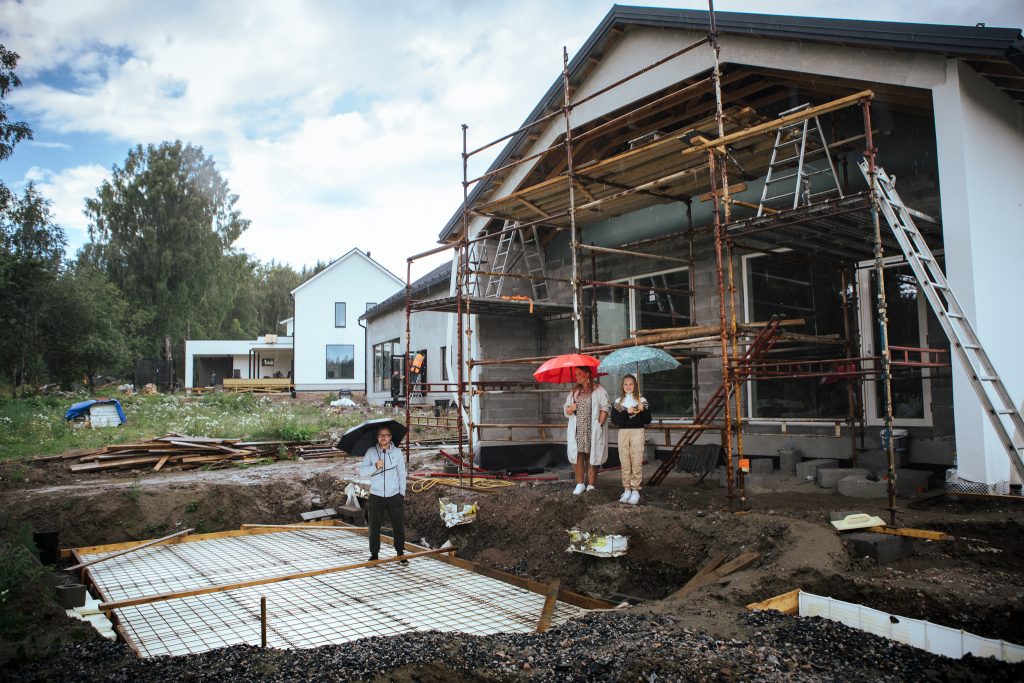Reducing the carbon footprint of construction is not expensive or difficult. When you reduce the carbon footprint of your new home, you most likely also reduce the costs of living.
Read more about sustainable construction on this page.

A sustainable construction method means designing a building to have a long life cycle. A sustainable building does not waste energy, and its materials are manufactured with consideration to climate emissions and the limited nature of natural resources.
Reducing the carbon footprint of construction is not expensive or difficult. When you reduce the carbon footprint of your new home, you most likely also reduce the costs of living.
Read more about sustainable construction on this page.
A well-designed house will retain its value and adapt to changing needs. Because of this, houses should be designed to serve residents of different ages and levels of fitness. So make sure to reserve a sufficient amount of time and resources for the design and planning phase.
The carbon footprint is the indicator for buildings’ carbon emissions. A building’s carbon footprint covers the building’s entire life cycle, from the manufacturing of the construction materials to demolition. This time period includes the building’s construction phase and the time for which the building is used.
Even if you primarily intend to build a suitable home for yourself or your family, you should look beyond the present. If the house is easy to maintain and repair, its life cycle may be hundreds of years. As construction has a large carbon footprint, there is no sense in constructing a building with a short life cycle in mind.
The use phase contributes the most to a detached house’s carbon footprint through the building’s energy efficiency and the forms of energy used.
The carbon handprint refers to the positive climate impact, which simultaneously compensates the building’s carbon footprint. A building’s carbon handprint covers things such as innovative utilisation of waste energy. Other examples of possible methods include generating more renewable energy, such as solar power, than the building needs and supplying the excess energy to the electrical grid or a neighbouring building, or generating heat for the district heating network.
A carbon reservoir also compensates the building’s carbon footprint. A carbon reservoir stored in construction materials for a long period of time, at least 100 years, is a carbon handprint. Wood is the best-known and most commonly used construction material that sequesters carbon – favour locally produced, certified Finnish wood in construction.
By choosing the right plot, you can save costs both during the construction phase and while the building is lived in. From a climate point of view, a plot has a good location when everyday services can be reached on foot or by bicycle. Plot location also affects the retention of the building’s value.
The less soil preparation and soil replacement is needed and the less trees have to be felled and soil excavated for a building’s foundation, the smaller its carbon footprint and costs.
When choosing a plot, you should find out what forms of renewable energy are available. Is the plot located in a protected groundwater area, i.e. is drilling a geothermal well an option? The plot’s soil type also affects the sensibility of drilling a geothermal well.
The plot affects the building’s energy consumption. In the winter, it is colder by several degrees in low-lying, open areas than in the middle of the woods, and the average annual temperature is lower by several degrees compared to a hill facing south, for example.
Additionally, if there are no elements around to provide shade, the need for cooling in the summer may increase energy consumption significantly as the climate continues to warm up.
In order for solar power to be utilised, there should be no elements such as retained trees blocking the sun from reaching the solar panels and collectors.
A soil survey is required for the planning of the foundation. A soil survey should be requested before making a purchase offer for a plot, especially if the plot is located on a hill or if the soil composition of the construction site cannot be deduced through a terrain survey.
Comfort is a quality factor that contributes to the building’s longer service life, as a comfortable home is also well taken care of.
Changes are affordable in the drafting phase, expensive in the construction phase and even more expensive if you do not notice them until you are already living in your new home. Alterations also increase the building’s carbon footprint.
A well-designed house can adapt to a variety of needs. It offers room to spend time together, engage in your own activities and carry out various daily routines. Multipurpose rooms that are easy to adapt reduce the amount of square metres needed in a home.
Adaptability and versatility of use mean that the dwelling can be adapted to a variety of situations without changes to the building’s structures. For example, the TV space can be turned into a fitness space by moving the coffee table aside and putting a rowing machine in its place.
Every unnecessary square metre eliminated from the plans currently saves €2,000 on average in construction costs and reduces the building’s carbon footprint. It also results in more savings during the building’s residential use. If you want to save in costs and reduce the building’s environmental impact, you should eliminate unnecessary square metres from the plans. The most expensive square metres are usually found in the kitchen and wet rooms.
Adaptability refers to the ability of the building or structure to adapt to functional changes or changes in the technical systems or purpose of use during the building’s use.
You do not have to make your home excessively large in consideration of future needs if you notice during the design phase that you can easily enlarge your home as your need for space increases. Similarly, if your family size and need for space decrease as a result of changes in your life, you can divide your home into two dwellings, for example.

You can reduce a building’s carbon footprint by replacing its materials with low-carbon options, where possible, and minimising the amount of material used. The longer the chosen material can serve its purpose, the smaller its carbon footprint.
It is essential to design the foundations and load-bearing structures in particular to be made of materials with as long a service life as possible.
The functionality of building components that provide protection from moisture is an important factor in the building’s durability. The exterior and surfaces are easier to repair, maintain and replace as necessary.
So choose sustainable and durable materials suitable for their purpose of use, and take into account their repairability and adaptability and the recyclability of the materials at the end of the building’s life cycle.
The emissions database for construction makes it relatively easy to compare the carbon footprints of various materials.
| Wood • One cubic metre of wood sequesters 1,000 kilograms of carbon dioxide on average. • Wood can function as a carbon reservoir for hundreds of years. • The most ecological wood option is locally produced, FSC-certified Finnish wood. • Wooden building components can be reused to some extent, and their reuse will increase in the future. |
| Brick • Brick is a construction material with a long service life. Its durability is its strength. • The older the brick, the smaller its carbon footprint. • By recycling a brick, you can save up to 90% of its carbon footprint. |
| Concrete • In order to reduce the carbon footprint of concrete, you should favour ‘green concrete’ and replace poured concrete with lighter and more environmentally friendly block products. • Concrete is required for certain purposes of use, and replacement products are not always available at a reasonable price. • If a more environmentally friendly material option or ‘green concrete’ is not available, the best way for the developer to save the climate and their money is by pursuing material efficiency. |
| Steel • Low-emission steel is recycled. • Compare products. Sustainability is a market advantage. If a construction product is manufactured sustainably, you can usually find a mention of it on the manufacturer’s website. • In Finland, waste iron and steel are recycled efficiently. Depending on the type of steel, up to 90% of the steel manufactured at a factory may be recycled. |
| Insulation • From a low-carbon perspective, wood-based insulation is the best industrially manufactured insulation material. • For example, the carbon handprint of wood-based cellulose wool is up to ten times greater than its carbon footprint. Because of this, it also compensates other construction products’ carbon footprint. • The thermal insulation of the walls, ground floor and roof has a major impact on the building’s energy efficiency and, through it, the heating energy’s carbon footprint and costs. |

Once the drafts have been refined into a feasible solution, the next step is to apply for a building permit. The principal designer is responsible for the main drawings, i.e. site plan, floor plans and elevation and section drawings. Other plans required at the start of construction include the foundation plans, structural plans, energy declaration, moisture control plan and plans for the water supply, drainage, heating and ventilation systems. They should be completed before applying for a building permit. All the participating designers and engineers are involved in this phase of the building project.
The placement of building services affecting the building envelope, such as solar panels or air-source heat pumps, should be decided during the preparation of the main drawings.
Foundation engineering is carried out on a case-by-case basis, with consideration to the construction site’s unique characteristics.
Finding the best foundation solution during the design phase may also make carbon-neutral construction possible at a more challenging construction site.
From an environmental perspective, the essential thing is for the foundations to be energy-efficient and have a long service life. Material efficiency should also be pursued as long as it does not reduce durability and energy efficiency.
The foundations’ carbon footprint arises from the soil, materials and their transport. The same things also make up the foundation costs.
Rakennustutkimus RTS Oy’s calculator (in Finnish) divides a detached house’s construction costs into 20 areas with adjustable quality levels. The calculator is well-suited for preparing cost estimates in the initial phase.
| Ground floor A well-made foundation and durable ground floor contribute to the building’s long life cycle. Typically, there are two alternative ground floor structures: A ground-bearing concrete floor slab or a suspended ground floor supported by foundation pillars, for example. The ground floor’s moisture performance must be planned and implemented carefully. To ensure a long service life, it is essential to drain any surface water next to and below the building. The greatest risk of damage posed to the ground floor is soil moisture leaking into the structures. |
| Exterior walls As the building has a large exterior wall area, a great amount of heat also evaporates through it. In exterior walls, the essential considerations are energy efficiency and protecting the walls from moisture. Of wall materials made of a single material, wood has the lowest carbon dioxide emissions and also functions as a carbon reservoir. Rodent-proof mesh, sufficient vents, functional sheathing boards and a carefully implemented vapour barrier on the inside are essential for the functionality of the multi-layer structure. The repairability of the structures prolongs the building’s life cycle. Walls made of a single material are less susceptible to damage than multi-layer walls. |
| Roof A climate-friendly roof is energy-efficient and has a long service life. Energy efficiency depends on the thermal insulation capacity, while longevity arises from durable materials and maintainability. Another factor that plays a role is the carbon footprint of the manufacturing of the selected materials. The roof’s watertightness and inspection of its functionality extend its service life. Energy efficiency is affected by the roof’s U-value, i.e. overall coefficient of heat transfer. The U-value can be improved by increasing the insulation thickness. A green roof serves as a carbon sink and can last for a long time if implemented well. |
An energy performance certificate is a calculated estimate of a building’s energy consumption while in use. An energy performance certificate is also required when applying for a building permit.
The energy efficiency rating indicates the probable costs of living in the building. The higher the rating, the less you will pay for heating. Energy efficiency and the use of renewable energy are essential factors when aiming for low carbon dioxide emissions.
Structural heat loss occurs primarily through the exterior walls and roof.
Heat loss is increased by
Heat loss is reduced by
In Finland, heating consumes the most energy in buildings. An investment in renewable heating energy pays back its expensive purchase price in the form of reduced housing costs.
From a climate point of view, the best form of heating energy is renewable energy. The best renewable energy sources are ones that do not release carbon dioxide into the atmosphere. Every building is unique, which is why you should consider the best form of heating energy together with the principal designer and HVAC engineer.
| GEOTHERMAL HEAT Heats up the indoor spaces and domestic water | ELECTRICITY + AIR-TO-WATER HEAT PUMP Heats up the indoor spaces and domestic water | DISTRICT HEAT Heats up the indoor spaces and domestic water |
|
|---|---|---|---|
| Heat source | Heat generated by the sun, sequestered in soil. 100% renewable. | Heat generated by the sun in the air. 100% renewable. | The fuels used by energy companies include natural gas, wood-based fuels, biofuels, recycled fuels, oil, biogas, etc. |
| Operating principle | Heat is recovered from a geothermal well or heat recovery pipes installed on the property and then channelled to the building’s heating network through geothermal equipment. | The equipment recovers heating energy from the outdoor air and then channels it into a hydronic heating system. Requires an additional heat source, such as electricity, during the cold season. | The heat is purchased from a local district heating company (Lahti Energia), which channels the heat to the building’s heating network via district heating equipment placed in the machine room. |
| Heat distribution method | Hydronic heating, usually floor heating. | Hydronic heating, usually floor heating. | Hydronic heating, usually floor heating. |
| Comfort of use | Easy to use. You are responsible for having the equipment serviced. | Easy to use. You are responsible for having the equipment serviced. | Easy to use and worry-free. You can buy a maintenance service along with district heating. |
| Ensure | Dimensioning of the borehole and equipment based on need. A reliable supplier is more likely to be able to supply spare parts in the future. | Determining the heating power required. A reliable supplier is more likely to be able to supply spare parts in the future. | If the distance between the machine room and the district heating connection is more than 20 m, each additional metre costs €120 (June 2021). |
| Climate impacts | If the amount of heating power required is determined correctly, the electricity generated by the equipment may be sufficient. If the electricity is ‘green electricity’, climate emissions are caused by the drilling of the well, and the equipment’s materials, manufacturing and maintenance. | Depends on the generation method of the purchased electricity. If ‘green electricity’ is used, the climate impacts are caused by the equipment’s materials, manufacturing and maintenance. | Depends on the energy used by the energy company. Lahti Energia has reduced its carbon emissions to less than a third compared to 1990. The expansion, upkeep and maintenance of the district heating network cause climate emissions. |
| Purchase costs | Depends on the borehole’s depth and the heat pump’s efficiency. More expensive than for district heat. | More affordable than for geothermal heat, as no borehole is needed. | The connection fee is €3,600 (June 2021), when district heat is indicated as the type of heating in the local detailed plan. |
| Running costs | Roughly half of the running costs of district heat (a 120 m2 detached house completed in 2010). | 15–20% more expensive than geothermal heat (a 120 m2 detached house completed in 2010), 30–35% more affordable than district heat. | Basic fee + energy rate + possible other service fees. See the Lahti Energia website for more information. |
| Considerations | Soil; groundwater areas; safety distances to buildings, plot boundaries and neighbours’ wells. | Consider the equipment’s placement, as an air-to-water heat pump is relatively loud. | Lahti Energia’s ‘Green Heat’, an ecological form of heating energy for customers connected to the district heating network, additional fee + €0.99/MWh (June 2021). |
Prepare for cooling that will inevitably become necessary in the next 10–20 years. Also reserve a space for cooling equipment in the machine room. A cooling function can be added to most heat pump systems. In Finland, it also stays cool at night in the summer. Consider whether you can use intensive ventilation at night for cooling.
You can also efficiently reduce the thermal load with structural choices:
| In most cases, new buildings are equipped with mechanical ventilation. The reasons for this include its ease of use and functionality in all weather conditions and throughout the year, and the ventilation equipment’s heat recovery capacity. It makes the building more energy-efficient. The recovery of thermal energy from exhaust air reduces the building’s need for heating. Energy savings also constitute cost savings. • Automation makes mechanical ventilation easy to use and reliable. • Mechanical ventilation with heat recovery saves heating energy. • The carbon footprint of mechanical ventilation arises from the electrical energy used by the ventilation, as well as the manufacturing and maintenance of its ducts and equipment. • The equipment and ducts take up space, increasing the number of cubic metres that need to be built. • A system equipped with an exhaust air heat pump facilitates heat recovery throughout the year and channels the heat to be used for heating up domestic water. • An appropriate ventilation system airs out the rooms where people spend time. |
| Passive ventilation functions without electricity. It utilises the buoyancy effect, in which warmed air rises up. Natural draught causes the exhaust air to exit the building through the exhaust flue, while replacement air is supplied through vents in a controlled manner. Compared to mechanical ventilation, passive ventilation is quiet and has little need for maintenance. • Passive ventilation requires the building’s resident to stay active and have the skills to keep the indoor air pleasant throughout the year. • As the climate continues to warm up, reducing the thermal load with structural methods is a sensible solution that increases comfort in the summer. |
The average water consumption per person in Finland is 155 litres per day.
Energy can be saved through good engineering and energy-efficient lighting and household appliances.
You should determine and prepare the conditions for utilising solar power, even if you do not plan on purchasing a solar power system immediately.
| Supplementary energy sources You should make preparations for solar power, even if you do not install a solar power system immediately. These preparations are affordable to make during the construction phase. The conditions for utilising solar power are in place when the climatic conditions and the position of a building or structure such as a car shelter on the plot are appropriate. If you want to install a solar power system, you must contact the building inspection services to find out whether you require a building permit. You must also notify your electricity network company. |
| Lighting Appropriate high-quality lighting design, including automated lighting, saves energy. For outdoor lighting in particular, you should consider utilising dusk-to-dawn or motion sensors or time switches. The energy consumption of lighting is generally very affordable when using LED lighting. At some point, however, even LED lights reach the end of their life cycle. A material-efficient and climate-friendly solution would be to choose lighting that allows the LED light source to be replaced easily without a need to replace the whole lamp. |
| Equipment Households have a great number of appliances. From a low-carbon perspective, it is important for the equipment used the most to be durable and consume as little energy as possible. When choosing equipment, pay attention to the energy efficiency rating and warranty period. You should also weigh what appliances you actually need and how large they actually have to be. |
| Charging an electric car An increasing number of new cars are either all-electric or hybrid, and electric cars are also available for rent. Electric cars are becoming more common, and you should prepare for vehicle charging when constructing a new building. It is considerably cheaper to create the facilities for a charging station during other construction work than to carry out alterations later. |

A short schedule is a quality and safety risk in construction. Ask for recommendations and hire a capable site supervisor to oversee the process. Visit the construction site in person often, familiarise yourself with the work phases and keep documentation.
As unexpected things do tend to happen, you should leave room for them in the construction schedule. You should schedule the date of completion, but you should not hold on to it so firmly that potential delays during construction cause haste in the final phase at the expense of work quality. If everything goes smoothly without unexpected surprises, a few weeks of idle time in construction are no problem.
Visit the construction site yourself as often as you can and try to stay up to date on each construction phase. Take many photos and save them in a separate folder in a cloud, for example. They may come in handy later.
Ask the builders if there is something you do not understand, and make sure that they understand the plans. If the plans need to be clarified or contain discrepancies, contact the principal designer. They are responsible for the consistency of the plans.
Arranging weather protection during construction is usually the constructor’s responsibility. In the event of a sudden storm or heavy rain, however, even good weather protection may fail, and poor timing may leave the building exposed to the weather for the weekend or a longer period of time.
Until the structures are safe from the weather under a watertight roof, you should be prepared to visit the site frequently. If the construction site is located far away, ask or hire someone living nearby to check that the tarps and plastic covers are in place.
When ordering products for delivery to the plot, the responsibility for weather protection is transferred to the client immediately upon the receipt of the product, regardless of whether you are personally there to receive the product. Products are usually packed well for transport, but storage on the plot is a different matter entirely. If the constructor is tasked with receiving the products and protecting them from the weather, make sure that this is actually covered by your agreement and is done.
A moisture control plan must be prepared as an appendix to the building permit. It should be available on the construction site, so that all the constructors are aware of it
A great deal of waste is generated during the construction phase. Packaging waste primarily consists of plastic and wood. Different amounts and types of construction materials are also left over, depending on the construction method. Appropriate recycling of waste and leftover materials is important, and modern builders consider this to be a matter of fact.
When the construction process involves the use of large prefabricated parts, a large proportion of the leftover materials is left at the house factory and is never transported to the plot. House factories usually seek to recycle their leftover materials efficiently. Wood materials are used for smaller-scale wood construction, while chips are used as packaging material, and sawdust is used as animal bedding or in energy generation.
From the plot, the waste is transported for recycling to a sorting station. In Lahti, waste is taken to the sorting station Pilleri in Kujala. Untreated, clean and dry wood can also be donated to places such as schools for woodworking projects or recycled through online market places. They are also good places to find people to come and pick up wood pallets and other waste wood.
The sorting process is easier if you sort the waste as it is generated. For some builders, sorting is a matter of fact – however, you should confirm this when drawing up contracts. The other option is to exclude waste sorting and/or construction site clean-up from the contract and take on the task yourself. This means undertaking to visit the construction site several times a week, which also enhances your self-monitoring.

Maintenance manuals have been mandatory for detached houses since 2004. A maintenance manual is the most important tool in the building’s upkeep and maintenance.
You can start putting a maintenance manual together by getting a cardboard box. At the construction site, take all the user instructions and other important documents found in packages unpacked during construction and store them in the box.
You can also take photos of warranty receipts and save user instructions in their own folders in a cloud or maintenance manual app, such as KotiApp (in Finnish). Of course, your maintenance manual can also be a traditional folder in which you organise all the documents saved during the construction phase, list the regular needs for maintenance, and record the maintenance measures and other renovations carried out.
The maintenance manual is also an important document for future residents of the building. It will help you prepare for future repairs.
If the technical warranty provided by the manufacturer for the roof is 30 years, for example, the roof will probably need to be replaced after this period of time. Before that, the roof will require annual upkeep, cleaning, regular condition inspections and maintenance.
Once the 30 years are up, the heating system may also require an upgrade. After 50 years, the board cladding, windows and doors may need to be replaced, and the same applies to the domestic water piping, heating pipes, radiators and drains. At that time, the original builder is not necessarily around anymore to carry out repairs on the building, but the durability and maintainability of the materials and products should still be taken into consideration when making choices.
If you do not carry out appropriate, regular maintenance and repairs as needed, you may be faced with a major renovation sooner than anticipated. You should therefore monitor the house’s condition regularly, clean the eaves gutters and yard drains, go up to the roof, check the plinths, drainage wells, the condition of the facade cladding, etc.
Modern heating and ventilation systems are usually smart enough to notify you if they are out of order or in need of maintenance. Unless the required maintenance measure is a routine measure that you can handle yourself, such as replacing the ventilation machine filter, you should turn to a professional.
Many household appliances have a service life of 10–15 years, after which they should be replaced. If you purchased all new appliances for your new home, you should prepare both financially and mentally for the time when they all need to be replaced.
For some products, the warranty may become void if they are serviced or repaired by someone other than an authorised professional or otherwise contrary to the warranty terms. If the warranty is valid, you should check the product manufacturer’s warranty terms before starting repairs.
Builders of detached houses are the orchestra conductors tasked with overseeing the project from start to finish, from a dream into a real home.
There is no one single recipe for building a house. However, all sustainable houses are designed to have a long service life and low energy consumption, in addition to adapting to changing life situations. This is a good starting point for the design and engineering process.
This guide will hopefully help you navigate the multitude of options and find the red thread that allows you to stand by your choices with confidence and satisfaction.
We wish you resilience in building your home!